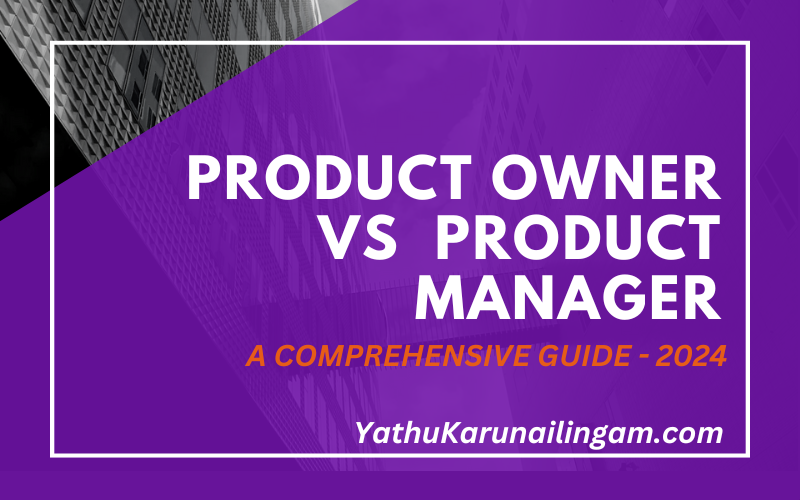- September 22, 2024
- by uyuwh
- Blog
- 0 Comments
Understanding the various roles involved in product development is a difficult task, particularly when you are trying to navigate the complex world of product creation. The Product Owner and Product Manager are two of the most important positions. These titles, while similar in sounding, have distinct responsibilities that are crucial to bringing a new product from conception to market.
Clarity between these two functions is becoming more important as businesses grow. Knowing how each role impacts team dynamics and project success will be important in 2024. If you want to learn more about how products are created, or if you just want to understand the difference between product owner and product manager, it’s important to know what they do. Discover their unique responsibilities, and how they work together to create amazing products.
Table of Contents
Responsibilities as a Product Owner
In agile teams, the Product Owner is a key player. They act as a bridge between stakeholders, development teams and ensure that everyone is on the same page.
One of the primary responsibilities of product managers is managing the backlog. Prioritizing features is based on business value and customer needs. This list is continually refined by the Product Owner, who adapts it to changing priorities.
These stories also provide clear user-stories that developers can use to create valuable functionality. These stories should explain both what users want and why they matter.
A regular communication with all stakeholders is also essential. A product owner gathers feedback, insights and helps to refine the vision of the product over time.
Collaboration with the team of developers during sprints is essential to achieving goals. Their active involvement keeps projects on course and fosters a common understanding among all team members.
Responsibilities for a Product Manager
What does a product manager do? A product manager plays an important role in the development of a new product. They act as a bridge between different teams to ensure everyone is on the same page.
Their primary responsibility is to define the product strategy. Understanding market needs and identifying innovation opportunities are key.
The product manager will also prioritize features according to customer feedback, technical feasibility, and business goals. To balance these factors, you need strong analytical skills as well as an eye for details.
To ensure smooth implementation of plans, they collaborate closely with the engineering, sales, and marketing teams. Communication across departments is key to accelerating project progress.
Moreover, by monitoring performance metrics after launch they can make informed decisions about future improvements and iterations. They are able to adapt so that their products meet not only initial expectations, but also evolve over time in order to satisfy users’ demands.
Key Difference Between Product Owner and Product Manager
Although the roles of product owner and product manager often overlap, they differ in their focus and function.
A Product Owner is primarily involved in agile teams. They focus on maximising the value of the backlog and ensuring user stories are aligned with business goals and customer needs. They are detail-oriented and focus on daily tasks.
A Product Manager like Yathu Karunailingam, on the other hand takes a wider perspective. This role includes market research, strategic development and a long-term view of the product line. They interact with different stakeholders to gain insights that help shape the product direction.
Both roles are centered on communication and collaboration but their priorities differ. While the Product Owner focuses on execution, the Product Manager is more focused on market trends and driving growth initiatives. Understanding these nuances will help clarify the dynamics of any team focused on product development.

How Do They Work Together in an Organization?
Collaboration between a product owner and a product manager is essential for the delivery of successful products. Each brings unique perspectives to the development process.
The Product Owner is responsible for the tactical aspect, making sure that the team of developers has clear tasks and priorities. This role is responsible for translating user stories into detailed specifications, which helps to ensure smooth execution.
The Product Manager has a wider strategic perspective. They align product vision to business objectives and define market needs. They guide long-term directions by understanding customer feedback.
Communication is key to their partnership. Regular meetings can help to synchronize the efforts and identify any potential roadblocks. This alignment helps ensure that both teams work towards common goals, while remaining agile in response to changes.
They combine their expertise to create more innovative solutions that ultimately result in better outcomes for both users and stakeholders.
The Two Roles Require Different Skills
Both Product Owners & Product Managers have a few essential skills in common that are key to their success.
Communication is key. The ability to communicate clearly is required for both roles, whether you are working with teams or stakeholders.
Also, analytical skills are important. To make informed decisions, they must be able to assess market demands and interpret data.
Another key trait is adaptability. Being able to adapt strategies in response to new insights is important because the tech landscape changes rapidly.
Both positions must have a customer-first mentality. Understanding the needs of users helps to create products that are successful in the market.
Leadership skills are essential for motivating and guiding teams, while also ensuring that everyone is aligned to the larger business goals. Each skill is important in successfully navigating the complexity of product development.
The Right Role to Achieve Your Career Goals
Your career path can be significantly affected by your choice between Product Owner or Product Manager. It is important to assess your strengths. You might be a Product Owner if you enjoy working in an Agile environment and are focused on team dynamics, backlog prioritization and team dynamics.
If you are more interested in strategic thinking and analysis of the market, then consider becoming a product manager. This role focuses on long-term planning and stakeholder engagement.
Take into account your own interests. Are you more interested in working with the development team or focusing on customer needs? Understanding your motivations will help you determine which job is best for you.
Likewise, networking within the two fields can provide useful insights. Talk to people who have already walked the path you are considering to get a better understanding of daily responsibilities and opportunities for growth. You should make a decision that reflects not only your skills, but also the direction you want to go in.
Conclusion
Anyone working in tech or product development should understand the difference between Product Owner and Product Manager. Both roles are important, but they serve different purposes within an organisation.
The Product Owner is responsible for maximizing the value of the development team and ensuring that requirements are aligned with customer needs. This role is tactical and deals directly with the day-to-day activities of agile teams.
The Product Manager, on the other hand takes a wider view and is responsible for the long-term strategy as well as the positioning of the market. They work across departments to achieve success.
Both positions have different responsibilities, but they must work together to make sure that the products are not only meeting business goals, but also providing real value to their customers.
Consider your interests and strengths when you are exploring career paths within this field. This will help you decide which role best suits your goals. Understanding these nuances can help you navigate more effectively your professional journey.
FAQs
What is the role of a product owner?
A Product Owner’s main responsibility is to represent the interests of stakeholders and customers. It is their responsibility to understand and prioritize the needs, wants, and goals of the stakeholders and customers, and communicate them effectively to the developers. They must also create and maintain a backlog of features or improvements that should be included in the next release.
What are the main duties of a product manager?
A Product Manager’s main responsibility is to develop and implement the product strategy. They are responsible for setting the vision, goals, and objectives, identifying market targets, conducting research, creating product road maps, and managing cross functional teams to ensure successful deliveries of products.
What are the difference between product owner and product manager roles?
A product owner decides what features and improvements to include in each release, based on the needs of customers and stakeholders. The Product Owner works closely with the Development Team to ensure that these decisions are in line with the product vision. A Product Manager, on the other hand makes strategic decisions regarding the long-term goals of the product and which markets to target as well as how to position the product within these markets.
Can a person perform both roles at the same time?
It is possible to have one person take on both roles, but it’s not ideal. Both roles require different skills and have different focuses. Both roles must be given the same amount of attention to ensure they are both successfully executed.
How are these roles interconnected?
The collaboration between these two roles are crucial to the success of product development. The Product Owner collaborates with the development team to complete daily tasks like sprint planning, backlog refining, and creating user stories, while also collaborating with stakeholders for higher-level goals. The Product Manager works with cross-functional groups to ensure the product vision is realized, and that it aligns with the business objectives. They communicate market insight and customer feedback to Product Owners for consideration when prioritizing the backlog.
Can an Owner of a product become a Manager of a product?
It is possible to move from a product owner into a product manager role. They can gain the skills and knowledge necessary to assume the strategic responsibilities as a Product manager by gaining experience with understanding customer needs, managing backlogs and working closely together with stakeholders. This transition may require additional education or training in areas like market research and project planning.





